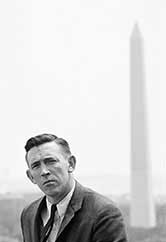Mad Men Novelist At The Peace Corps: Doug Kiker
If there was one HQ staffer who could have walk straight onto the set of the current hit, Mad Men, is was Doug Kiker of Griffin, Georgia. Kiker was the original “mad man” in his brief time at the Peace Corps during those early days when he was chief of the division of public information.
 He would leave the Peace Corps in 1963 for the New York Herald Tribune, and on his first week on that job, he was riding in the press bus in the motorcade with JFK when the president was assassinated. By 1966, he was with NBC News as an on-air reporter and he would remain with that network for the rest of his life. He died of a heart attack in 1991 at the age of 61.
He would leave the Peace Corps in 1963 for the New York Herald Tribune, and on his first week on that job, he was riding in the press bus in the motorcade with JFK when the president was assassinated. By 1966, he was with NBC News as an on-air reporter and he would remain with that network for the rest of his life. He died of a heart attack in 1991 at the age of 61.
Kiker came from the south, from Presbyterian College in Clinton, South Carolina, majoring in English and wanting to be a writer.
His first short story was published in the Yale Review while he was still an undergraduate, and also while he was an undergraduate he worked as a reporter in Spartanburg, South Carolina, assigned for a good part of this time to covering the Senate race between Strom Thurmond and Olin Johnston.
As most of the ‘mad men’ of that time he has the uncanning ability to be right in the center of the action, shown by being on the bus in Dallas that fateful day.
He went from college into the Korean War, joining the Navy, and after Officer Candidate School, was assigned as a gunnery officer aboard a carrier in the middle of the Korean War. Later he taught at Newport Officer Candidate School before his discarge as a Navy Lieutenant.
He worked next for the Atlanta Journal, and was there for the sit-ins at the lunch counters in North Carolina and covered much of the civil rights movement. He became somewhat of an expert on the subject, not only in the South, but across the country, and published a major article on desegregation for the old Look Magazine.
And he was also writing fiction. In 1957, he published The Southerner, the story of a black educator who goes from North to South to participate in the struggle. The book was a success in the U.S. and overseas, and he followed that novel in 1959 with Stranger on the Shore, a novel about life in the peacetime Navy.
By 1961 he was living in Washington and writing for the Atlanta Journal, a weekly column that also appeared in other Cox newspapers, but he left that in early 1962 to join the new Peace Corps as the chief of Public Information.
The first and original director of Public Information was a guy named Ed Bayley. Bayley had had a decade long career as a reporter of the Milwaukee Journal. He, too, had been in the Navy, but in WWII, and then returned to Wisconsin and worked as a reporter. Immediately before coming to the Peace Corps he was the executive assistant to Wisconsin’s Governor Gaylord Nelson. When he left the agency he took over the job as the information director of the new AID.
Public Information was key division in the the agency in those early days. They were ‘selling’ the Peace Corps to the public. Gerard T. Rice in his book, The Bold Experiment: JFK’s Peace Corps, writes that “The Peace Corps’ public relations exercises were slick, professional, and effective. Television cameras were invited into training camps; Volunteers appeared as guests on ‘What’s My Line’; celebrities’ visits to overseas programs made national headlines. The President’s association with the Peace Corps was particularly well publicized: meeting Volunteers in the Rose Garden as they left for overseas or congratulation them on their return.”
Bayley and then Kiker steered the good news into the press. It wasn’t hard. Most of the reporters who covered the Peace Corps in D.C. and elsewhere were sympathetic to the idea of the agency and anxious to help. As Kiker explained in 1962, “We are neither in the business of publicizing our mistakes nor of hiding them.” But as Kiker, and everyone else knew, if “enough goofs” became known in the press, the Peace Corps would soon be out of business.
Luckily most of our early ‘goofs’ didn’t become public!
Speaking of “goofs,” Doug Kiker himself contributed to the genre. On a controversial visit Shriver made to the Philippines in 1962, Kiker was one of the entourage. He distinguished himself while in Zamboanga, by getting publicly drunk and singing aloud the colonial ditty, “The Monkeys Have No Tails in Zamboanga.” At each stop on the trek through the Philippines, Kiker’ continued his boorish behavior –including hitting on female PCVs.
Terrific photo! Who shot it?
I am afraid Maureen (above) is closer to the truth than I care to remember.
The photo was shot by this ‘kid photographer’ who hung around the Peace Corps in those early days. His name was Rowland Scherman…I don’t know what happened to him, however. Got famous, I guess.
Maureen has it “right on.” Kiker certainly failed to distuingish
himself while visiting the Peace Corps on the island of Mindinao.
He drank far too much and made of himself a pest around the
Peace Corps women.
[…] John Coyne Babbles – Mad Men Novelist At The Peace Corps: Doug Kiker […]